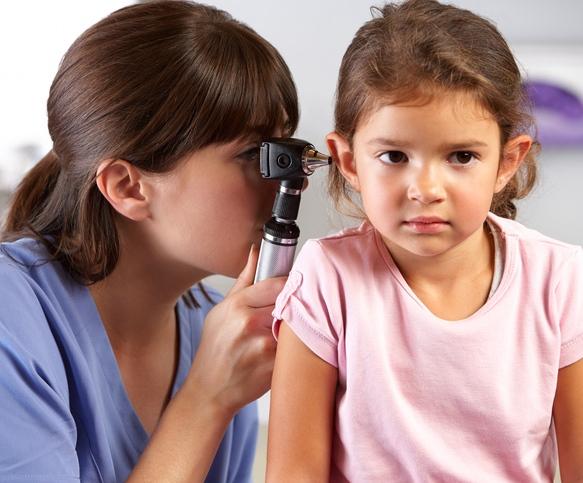Although "watchful waiting" (WW) is the recommended approach to antibiotic treatment for acute ear infections in young children, a recent survey of parents suggests that relatively few physicians fully explain the rationale for this approach, including the nature of acute otitis media (AOM) and the risks of antibiotic overuse.
The survey, described in the Journal of Applied Communication Research, showed that only 10% of parents recalled receiving information about the adverse effects of antibiotics, and only 4% reported receiving comprehensive information about the why and how of WW.
But the study also showed that parents who did remember hearing detailed information about WW were more likely to follow that advice.
Parents often skeptical
As noted in the report, WW involves providing antibiotics for young children with AOM but advising caregivers not to use the drugs unless symptoms persist. Although studies support the practice, parents "remain skeptical and generally unenthusiastic," and consequently the approach is underused, the authors say.
In the study, five researchers from Pennsylvania State University questioned a nationwide sample of 134 parents of children under 5 years old who had AOM. The parents had been provided with antibiotics to be used in case their children's symptoms didn't improve within a specified time.
The study's twofold aim was to examine how well parents' recall of healthcare providers' explanation and instructions matched American Academy of Pediatrics (AAP) guidelines on WW, and to assess the relationship between parental recollections and reported compliance with WW.
The AAP guidelines for pediatric AOM advise providers to use the clinical exam to determine if the patient has AOM, which is bacterial, as opposed to a viral condition, the report notes. For severe AOM, immediate antibiotic treatment is recommended, but the guidelines suggest WW for patients under 2 years old who have mild AOM and for those 2 years and older who have "nonsevere" AOM.
The guidelines say providers should explain the self-limited nature of most AOM episodes and the potential adverse effects of antibiotics. In addition, providers are advised to tell parents to monitor their children's condition, use analgesics (such as acetaminophen), and obtain follow-up care.
Few parents heard about antibiotic risks
Only 10% of the parents recalled getting information about the harmful effects of antibiotics, while 58% reported learning about the nature of AOM, and 64% reported being told about one or both of these topics, the report says.
Three fourths of the parents recalled being told to monitor their child's symptoms, but only 29% reported getting advice about medication for pain, and 22% reported an offer of follow-up care during the WW period.
Only 4% of the parents recalled receiving at least one of the two types of explanation (risks of antibiotics and the nature of AOM) and all three types of instruction, the authors found.
The survey also revealed that 27% of the parents did not comply with WW.
"Of parents who complied with WW, 63% reported that the physician explained the nature of AOM (versus 42% of noncompliant parents), 88% reported being instructed to monitor their children's symptoms (versus 61% in the noncompliant group), and 38% reported instruction to use medication to manage pain (versus 14% of the noncompliant parents)," the report says.
A statistical analysis indicated that compliance was significantly associated with having received information and advice on these three topics. The analysis showed that explaining the risks of antibiotics and instructing parents on follow-up care did not have statistically significant effects. But the number of parents who recalled hearing about antibiotic risks was so low (10%) as to prevent a strong test of the effect of this information on compliance, the authors said.
Misunderstandings revealed
In other findings, even when parents reported hearing explanations about the risks of antibiotics, their understanding of the subject was not necessarily correct, the survey showed. One participant reported, "If children are given antibiotics when it is not necessary, they can build up an immunity to them." This misunderstanding illustrates the challenge of understanding antibiotic resistance and the need for healthcare providers to more clearly communicate the dangers of overuse, the authors said.
The findings, the researchers said, suggest that providers don't fully follow the AAP guidelines when communicating with caregivers about WW, an interpretation that is consistent with high rates of injudicious antibiotic prescribing for AOM. But the results almost certainly also reflect parents' difficulty in understanding and remembering what providers tell them.
"The current study provides evidence that health care providers are not powerless to resist parents' misconceived desire for antibiotic treatment, but can use explanation and instruction to guide them toward compliance with WW," the researchers comment. "A starting point is ensuring that key elements of explanation and instruction are actually provided, which will also bring providers into alignment with AAP guidelines."
MacGeorge EL, Caldes EP, Smith RA, et al. Reducing unwarranted antibiotic use for pediatric acute otitis media: the influence of physicians' explanation and instruction on parent compliance with 'watchful waiting.' J Appl Commun Res 2017 (published online May 30) [Full text]
See also:
Related Jun 5 press release
























